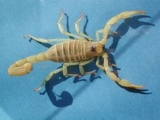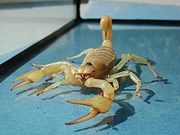
Giant desert hairy scorpion
Encyclopedia
Hadrurus arizonensis, the giant desert hairy scorpion, giant hairy scorpion, or Arizona Desert hairy scorpion, is the largest scorpion
in North America
, and one of the 8–9 species of Hadrurus in the United States, attaining a length of 14 cm (5.5 in). Its large size allows it to feed readily on other scorpions and a variety of other prey, including lizards and snakes. This species is usually yellow with a dark top and has lobster
-like pincers. It gets its common name
s from the brown hairs that cover its body. These hairs help it to detect vibration in the soil. A similar species is Hadrurus spadix
.
 Hadrurus arizonensis is distributed throughout the Sonora and Mojave
Hadrurus arizonensis is distributed throughout the Sonora and Mojave
deserts. In Mexico, the species' range flanks the Sea of Cortez in Sonora
and Baja California Norte. In the United States, it is found in the western two thirds of Arizona
, the Colorado Desert
and Mojave Desert regions of southern California
, southern Nevada
, and extreme southwestern Utah
. Arizona Desert hairy scorpions are a warm-desert species, specially adapted to hot and dry conditions. They are usually found in and around washes or low-elevation valleys where they dig elaborate burrow
s (up to 2.5 m or 8.2 ft) and emerge at night to forage for prey and mates. Other species commonly encountered living sympatrically with this species are: Smeringurus mesaensis, Hoffmannius confusus, and Hoffmannius spinigerus
s, spider
s, and small vertebrate
s. This is an aggressive and active scorpion, which, as with all scorpions, is nocturnal. Like all scorpions, the giant desert hairy scorpion gives birth to live young, which remain on the mother's back for a week or more before leaving.
is not very potent, and its sting is commonly perceived to be about as painful as a honeybee's sting. The venom has an value of 168 mg/kg. However, an allergic reaction to its venom can be fatal; symptoms can include difficulty breathing
, excessive swelling
, and prolonged pain
.
Scorpion
Scorpions are predatory arthropod animals of the order Scorpiones within the class Arachnida. They have eight legs and are easily recognized by the pair of grasping claws and the narrow, segmented tail, often carried in a characteristic forward curve over the back, ending with a venomous stinger...
in North America
North America
North America is a continent wholly within the Northern Hemisphere and almost wholly within the Western Hemisphere. It is also considered a northern subcontinent of the Americas...
, and one of the 8–9 species of Hadrurus in the United States, attaining a length of 14 cm (5.5 in). Its large size allows it to feed readily on other scorpions and a variety of other prey, including lizards and snakes. This species is usually yellow with a dark top and has lobster
Lobster
Clawed lobsters comprise a family of large marine crustaceans. Highly prized as seafood, lobsters are economically important, and are often one of the most profitable commodities in coastal areas they populate.Though several groups of crustaceans are known as lobsters, the clawed lobsters are most...
-like pincers. It gets its common name
Common name
A common name of a taxon or organism is a name in general use within a community; it is often contrasted with the scientific name for the same organism...
s from the brown hairs that cover its body. These hairs help it to detect vibration in the soil. A similar species is Hadrurus spadix
Hadrurus spadix
Hadrurus spadix is a large scorpion native to the southern deserts of North America. It is a burrowing scorpion which spends a lot of time digging in the sand and enlarging its burrow. A similar species is the Giant desert hairy scorpion.-Captive care:Hadrurus spadix can be housed in a big vivarium...
.
Habitat

Mojave Desert
The Mojave Desert occupies a significant portion of southeastern California and smaller parts of central California, southern Nevada, southwestern Utah and northwestern Arizona, in the United States...
deserts. In Mexico, the species' range flanks the Sea of Cortez in Sonora
Sonora
Sonora officially Estado Libre y Soberano de Sonora is one of the 31 states which, with the Federal District, comprise the 32 Federal Entities of Mexico. It is divided into 72 municipalities; the capital city is Hermosillo....
and Baja California Norte. In the United States, it is found in the western two thirds of Arizona
Arizona
Arizona ; is a state located in the southwestern region of the United States. It is also part of the western United States and the mountain west. The capital and largest city is Phoenix...
, the Colorado Desert
Colorado Desert
California's Colorado Desert is a part of the larger Sonoran Desert, which extends across southwest North America. The Colorado Desert region encompasses approximately , reaching from the Mexican border in the south to the higher-elevation Mojave Desert in the north and from the Colorado River in...
and Mojave Desert regions of southern California
Southern California
Southern California is a megaregion, or megapolitan area, in the southern area of the U.S. state of California. Large urban areas include Greater Los Angeles and Greater San Diego. The urban area stretches along the coast from Ventura through the Southland and Inland Empire to San Diego...
, southern Nevada
Nevada
Nevada is a state in the western, mountain west, and southwestern regions of the United States. With an area of and a population of about 2.7 million, it is the 7th-largest and 35th-most populous state. Over two-thirds of Nevada's people live in the Las Vegas metropolitan area, which contains its...
, and extreme southwestern Utah
Utah
Utah is a state in the Western United States. It was the 45th state to join the Union, on January 4, 1896. Approximately 80% of Utah's 2,763,885 people live along the Wasatch Front, centering on Salt Lake City. This leaves vast expanses of the state nearly uninhabited, making the population the...
. Arizona Desert hairy scorpions are a warm-desert species, specially adapted to hot and dry conditions. They are usually found in and around washes or low-elevation valleys where they dig elaborate burrow
Burrow
A burrow is a hole or tunnel dug into the ground by an animal to create a space suitable for habitation, temporary refuge, or as a byproduct of locomotion. Burrows provide a form of shelter against predation and exposure to the elements, so the burrowing way of life is quite popular among the...
s (up to 2.5 m or 8.2 ft) and emerge at night to forage for prey and mates. Other species commonly encountered living sympatrically with this species are: Smeringurus mesaensis, Hoffmannius confusus, and Hoffmannius spinigerus
Diet and behavior
It is a burrowing scorpion, but is commonly found under rocks containing moisture. Its diet consists of large insectInsect
Insects are a class of living creatures within the arthropods that have a chitinous exoskeleton, a three-part body , three pairs of jointed legs, compound eyes, and two antennae...
s, spider
Spider
Spiders are air-breathing arthropods that have eight legs, and chelicerae with fangs that inject venom. They are the largest order of arachnids and rank seventh in total species diversity among all other groups of organisms...
s, and small vertebrate
Vertebrate
Vertebrates are animals that are members of the subphylum Vertebrata . Vertebrates are the largest group of chordates, with currently about 58,000 species described. Vertebrates include the jawless fishes, bony fishes, sharks and rays, amphibians, reptiles, mammals, and birds...
s. This is an aggressive and active scorpion, which, as with all scorpions, is nocturnal. Like all scorpions, the giant desert hairy scorpion gives birth to live young, which remain on the mother's back for a week or more before leaving.
Toxicity
Although this scorpion is big, its venomVenom
Venom is the general term referring to any variety of toxins used by certain types of animals that inject it into their victims by the means of a bite or a sting...
is not very potent, and its sting is commonly perceived to be about as painful as a honeybee's sting. The venom has an value of 168 mg/kg. However, an allergic reaction to its venom can be fatal; symptoms can include difficulty breathing
Dyspnea
Dyspnea , shortness of breath , or air hunger, is the subjective symptom of breathlessness.It is a normal symptom of heavy exertion but becomes pathological if it occurs in unexpected situations...
, excessive swelling
Swelling (medical)
In medical parlance, swelling is the transient enlargement or protuberance in the body and may include tumors. According to cause, it may be congenital, traumatic, inflammatory, neoplastic or miscellaneous....
, and prolonged pain
Pain
Pain is an unpleasant sensation often caused by intense or damaging stimuli such as stubbing a toe, burning a finger, putting iodine on a cut, and bumping the "funny bone."...
.
External Links
- Desert Hairy Scorpion Husbandry accessed 07/08/2011
- Differentiating between H.arizonensis and H.spadix accessed 07/08/2011

